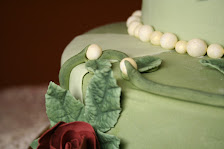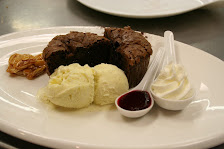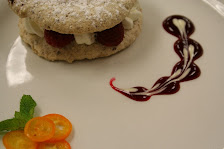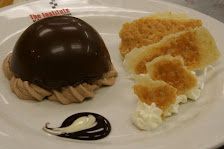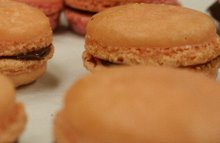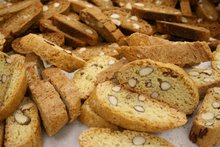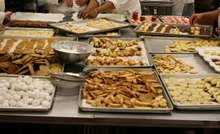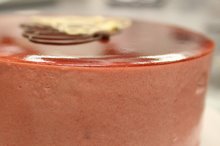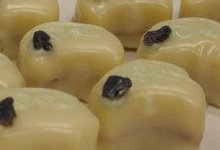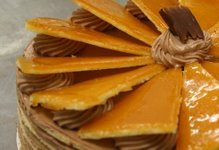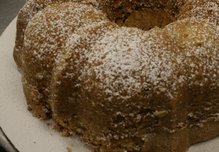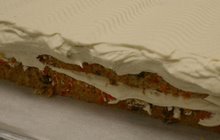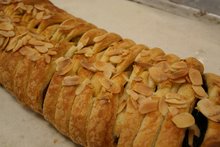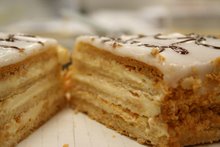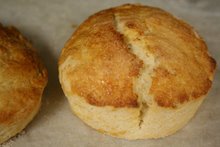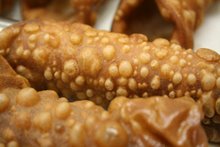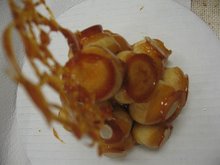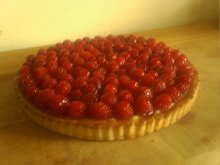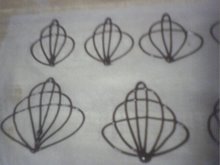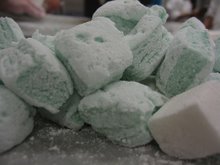Days 76, 77, 78, and 79: Bloated eels. Molten bouquets. Ransom notes.
If you're excited by the thought of stepping into the stale, shallow water of a neglected, moonlit canal in the middle of nowhere, casting in a short, baited line with a steel lead at the end, and pulling up a shiny, slithering eel to squeeze about hoping that something exciting might happen, then I suggest you consider the art of buttercream piping.
Let's talk about buttercream for a moment. Here in America we tend to prefer a coarser sort of frosting, one that's plentiful enough in powdered sugar for us to feel its not necessarily unpleasant grit on our palates and between our teeth. This supersweet frosting is an American classic; the recipe is even on the box of sugar. When we're exposed to a true buttercream (like the ones we've been making since Day 11) for the first time, it tends to shock us slightly for two reasons: it's not extremely sweet, and it's got that used-car-dealer quality of being almost too smooth to be trusted. Many of us turn tail and flee back to Gritty Sugarville, but if you give its silky cousin a second chance, you may surprise yourself by becoming addicted to it. (Allow me, as if you had a choice, to theorize about this phenomenon for a moment. If you consider our general food aesthetic as a nation, dessert equals sweet. It's a pretty one-dimensional sort of characteristic that has come to be the guiding principle in our hunt for dessert. Obviously there are other things we look for - texture, temperature, color - but from the standpoint of flavor, we look for "sweet" above all others. The somewhat more European (particularly French) tendency is to judge for other flavor components; buttery, for example, and spicy or herbal. This isn't, of course, to the exclusion of sweet, but the sweetness doesn't override the other flavors to the extent that you'd find in, say, a classically American cupcake. Even a palmier, which is simply a thin slice of puff pastry rolled and folded in pure sugar and baked to a deep golden brown, has a deeper and more complex flavor: nuttiness from the wheat, more nuttiness and a slight bitter note from the caramel, and the butter's... well... butteriness. The sugar is on stage, but there's no spotlight. The textures of American foods, too, tend to steer away from buttery, whereas European cookery and baking call for far more of it as a rule, the resultant texture being just a side benefit. Given these tendencies of the American palate, when we taste something that should be pretty familiar, like icing, and it's not only less sugary than we expect, but also has an exotic texture, our neophobia kicks in and we tend to revert to what's old and comfortable - in this case, gritty frosting. There's nothing wrong with the gritty stuff, but don't exclude the buttery stuff. Just make sure that you get a good one - make the Day 11 recipe if you have to. Its constitution should be moderately soft but not melting (until it’s on your tongue); its flavor should be sweet and buttery, with clear but not cloying highlights of whatever essences have been added (rum, vanilla, or the like); and its texture should be beguilingly satiny. You’ll like it once you’ve had a good one twice, you’ll see. I digress.)
Obviously a very common treatment of buttercream is in piping, and so began our lesson, and our segment on Cake Decorating. We started with the commonest of shapes, the shell. Now here’s where the eels come in. You fit a plastic pastry bag with a metal tip that has a star-shaped opening. Then you fill the bag with huge gobs of buttery icing. Buttery icing, by the fault of its own magic, melts at just a few degrees below body temperature. So, in keeping with the theme of pastry in general, you have to do it accurately, and you have to do it quickly. As you attempt to squeeze out practice shell upon practice shell, you realize that you’ve got melted buttercream (in other words, melted butter) all over your hands. Now you’ve got a giant, squishy, slippery mess between your hands, and the goal is to squeeze it in a very precise way in a very controlled rhythm. No problem. This eel even has teeth, in the form of the many-pointed star tip, with which, shocking as it may be, I managed to stab the webbing between my forefinger and thumb.
Hesitant as we were to retire from two full days of piping practice shells, Day 78 brought us to piping buttercream roses. This is clearly going to be a handy skill for those of us who go on to do any cake decorating, but it’s painfully obvious as well how much practice we’ll need before we can consider it a marketable still. If I ever get any good at it, I’ll remember this phase of my artistic life, perhaps, as my Salvador Dali Period. The beauty of a shell is that, even when the icing is melty, it’s still allowed to lay down. Petals, they tell me, are supposed to point up straight. No kidding.
After a day and a half creating these eerie miniatures - perfect set pieces for a Tim Burton film about a forgotten garden - we began working with royal icing. Made using egg whites and sugar, royal icing hardens to the point that it’s unpalatable; it’s the stuff you see all over gingerbread houses not only as a snow effect, but quite literally as glue - more to the point, mortar. Its very effective use as a décor element makes it a common medium for writing as well, which we learned to do using a cornet. Melting is no longer our problem, but speed is still a factor, since this cement is the quick-drying kind. It’s taken a number of decades for my handwriting to improve to its current, terrible level. Hopefully, if I practice forty or fifty quick times a day over the next twenty-something years, my kindergarten-royal-icing-scrawl will also be marginally legible by the time I’m in my mid-fifties. I’ll keep you posted.
The timbre of these first four last-quarter lessons is different. Everything we’ve created up to this point has been something we can learn to do well fairly quickly (with the exception of cornet work, naturally). These new skills are ones that will require hours and weeks and years of practice and honing before we’re even modestly proficient.
Wedding cakes, all of a sudden, seem a whole lot cheaper.
Monday, September 24, 2007
Wednesday, September 12, 2007
Days 72, 73, 74, and 75: Batter up…
The final four days of our third quarter (of four, for those of you who are a little slow with the arithmetic), saw us occupied with two activities: plating desserts and our final exam. Contrary to what you might expect, the former task received far more attention than the latter.
It sounds simple, and in a sense, it is. Plating means simply putting what you have created onto a plate in an attractive and sensible fashion for presentation. It must be somewhat trickier to teach plating than other parts of the course, since to do it properly requires good taste, which is not so easily imparted if the student doesn’t already have some. The main time-consuming aspect of the three days we devoted to it wasn’t about geometry or strategy or art, but production. Altogether, we turned out thirteen sauces; five types of cookies (as if we needed more of that!); seven mousses, curds, and confits; ten kinds of cakes and tarts, which, I suppose, were the actual desserts; four types of candied nuts and nut brittles; a giant pile of crêpes; fourteen ice creams and sorbets; and five or six additional décor elements like marshmallows or apple chips or spun sugar. (I was fortunate to have been assigned one of the few fruit components, which, after several pounds of cookie dough, was awfully refreshing.) Getting these things all together was obviously time-consuming, but once accomplished, the possibilities for combining them were limitless. If we were to use just four of all the components at our disposal, we could make something like 424,270 different desserts, according to my math skills (and therefore probably some other number altogether). We were directed to pay attention to texture, color, and flavor of course, keeping an eye open for negative space. In a flurry of activity, we assembled our desserts into fanciful and often hideous displays, from the crimson cast-sugar disc that arced gracefully atop a pear tart, echoing the reduced-wine sauce below it, to the drizzling of caramel sauce over the pinwheel arms of a candy-studded cake, in an excess that made it look quite like a frightening, melted carousel.
Philosophically speaking, it was exhilarating to whip up so many different dessert components so quickly, because it made us realize that we were now capable of doing so without panic attacks or fainting (not counting sugar coma). It was also a milestone because for the first time we addressed the issue which we will obviously encounter as we enter the kitchens of restaurants around the world: making our products look as good as they taste (which has been consistently excellent). My particular extraction of this philosophy resulted in a number of different combinations, among which three were particularly memorable. First, that old lounge act from every joint in town:: Molten Chocolate Cake with Vanilla Ice Cream, which I accompanied with whipped cream and raspberry sauce, along with a little nougatine (which you undoubtedly remember from Day 17) for textural interest. I proceeded then to the slightly nuder pasture that was my raspberry dacquoise. Having decided to go for a more minimalist approach, I accompanied it with only raspberry sauce striped with white chocolate, and a white chocolate curl on top of the dacquoise, echoing the sauce. Just before submission (oh, yes, we had to submit each plate to Chef for review, and, presumably, grading), I had a sudden burst of irrelevance and opted to do a little mint-kumquat-confit-thing. It worked though; I got a thumbs up on that one. My daring spurred to higher levels, I opted to finish with a molded chocolate mousse, enrobed in ganache, atop a bed of chocolate whipped cream. I accompanied this with mounds of regular (that is to say, non-chocolate) whipped cream, between which I had the brilliant judgment to place large placards of mille-feuille (Day 43). A little mound of whipped cream is not designed to keep a dense tablet of mille-feuille erect; it’s not a structurally sound configuration. Having decided (and announced, of course: a real shock) to do it, I carried on and managed to get them to stand up just long enough for a drive-by evaluation and a quick snapshot. The waiter that could carry this to the dining room, though, and keep those things standing, is worth his weight in gold. Easy as it is to assemble desserts when one has sixty or so components to choose from, and putting aside issues of individual taste (or exemplar lack thereof), I think the main lesson here was to realize that we have a long way to go in terms of learning what’s practical.
After the thrill of mock restaurant service, we came back to the refreshing simplicity of yellow cake. We each baked two layers of cake which we filled and frosted on the following day for the practical portion of our final exam (where refreshing simplicity dissolved with great haste into bleak reality.) I received a few points off for inconsistency of icing thickness and off-center adornments (two of my icing rosettes were not equidistant from those surrounding them), but in the end walked away none the worse for wear. The written part of the test covered all these cakes we’ve produced over the last several weeks. We know we’re not quite done with cake, though, as more than half of our last quarter, just around the bend, deals with wedding cakes.
And we round third base.
The final four days of our third quarter (of four, for those of you who are a little slow with the arithmetic), saw us occupied with two activities: plating desserts and our final exam. Contrary to what you might expect, the former task received far more attention than the latter.
It sounds simple, and in a sense, it is. Plating means simply putting what you have created onto a plate in an attractive and sensible fashion for presentation. It must be somewhat trickier to teach plating than other parts of the course, since to do it properly requires good taste, which is not so easily imparted if the student doesn’t already have some. The main time-consuming aspect of the three days we devoted to it wasn’t about geometry or strategy or art, but production. Altogether, we turned out thirteen sauces; five types of cookies (as if we needed more of that!); seven mousses, curds, and confits; ten kinds of cakes and tarts, which, I suppose, were the actual desserts; four types of candied nuts and nut brittles; a giant pile of crêpes; fourteen ice creams and sorbets; and five or six additional décor elements like marshmallows or apple chips or spun sugar. (I was fortunate to have been assigned one of the few fruit components, which, after several pounds of cookie dough, was awfully refreshing.) Getting these things all together was obviously time-consuming, but once accomplished, the possibilities for combining them were limitless. If we were to use just four of all the components at our disposal, we could make something like 424,270 different desserts, according to my math skills (and therefore probably some other number altogether). We were directed to pay attention to texture, color, and flavor of course, keeping an eye open for negative space. In a flurry of activity, we assembled our desserts into fanciful and often hideous displays, from the crimson cast-sugar disc that arced gracefully atop a pear tart, echoing the reduced-wine sauce below it, to the drizzling of caramel sauce over the pinwheel arms of a candy-studded cake, in an excess that made it look quite like a frightening, melted carousel.
Philosophically speaking, it was exhilarating to whip up so many different dessert components so quickly, because it made us realize that we were now capable of doing so without panic attacks or fainting (not counting sugar coma). It was also a milestone because for the first time we addressed the issue which we will obviously encounter as we enter the kitchens of restaurants around the world: making our products look as good as they taste (which has been consistently excellent). My particular extraction of this philosophy resulted in a number of different combinations, among which three were particularly memorable. First, that old lounge act from every joint in town:: Molten Chocolate Cake with Vanilla Ice Cream, which I accompanied with whipped cream and raspberry sauce, along with a little nougatine (which you undoubtedly remember from Day 17) for textural interest. I proceeded then to the slightly nuder pasture that was my raspberry dacquoise. Having decided to go for a more minimalist approach, I accompanied it with only raspberry sauce striped with white chocolate, and a white chocolate curl on top of the dacquoise, echoing the sauce. Just before submission (oh, yes, we had to submit each plate to Chef for review, and, presumably, grading), I had a sudden burst of irrelevance and opted to do a little mint-kumquat-confit-thing. It worked though; I got a thumbs up on that one. My daring spurred to higher levels, I opted to finish with a molded chocolate mousse, enrobed in ganache, atop a bed of chocolate whipped cream. I accompanied this with mounds of regular (that is to say, non-chocolate) whipped cream, between which I had the brilliant judgment to place large placards of mille-feuille (Day 43). A little mound of whipped cream is not designed to keep a dense tablet of mille-feuille erect; it’s not a structurally sound configuration. Having decided (and announced, of course: a real shock) to do it, I carried on and managed to get them to stand up just long enough for a drive-by evaluation and a quick snapshot. The waiter that could carry this to the dining room, though, and keep those things standing, is worth his weight in gold. Easy as it is to assemble desserts when one has sixty or so components to choose from, and putting aside issues of individual taste (or exemplar lack thereof), I think the main lesson here was to realize that we have a long way to go in terms of learning what’s practical.
After the thrill of mock restaurant service, we came back to the refreshing simplicity of yellow cake. We each baked two layers of cake which we filled and frosted on the following day for the practical portion of our final exam (where refreshing simplicity dissolved with great haste into bleak reality.) I received a few points off for inconsistency of icing thickness and off-center adornments (two of my icing rosettes were not equidistant from those surrounding them), but in the end walked away none the worse for wear. The written part of the test covered all these cakes we’ve produced over the last several weeks. We know we’re not quite done with cake, though, as more than half of our last quarter, just around the bend, deals with wedding cakes.
And we round third base.
Subscribe to:
Comments (Atom)



